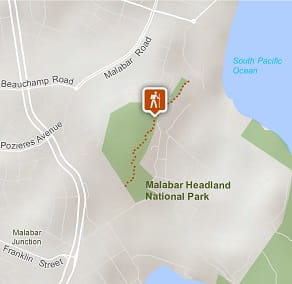Western Escarpment walking track
Malabar Headland National Park
Overview
Get back to nature on Western Escarpment walking track in Sydney's Malabar Headland National Park, near Maroubra. This short track through native heath boasts coastal views, bird life and wildflowers.
- Accessibility
- No wheelchair access
- Distance
- 1km one-way
- Time suggested
- 20 - 30min
- Grade
- Grade 3
- What to
bring - Hat, sunscreen, drinking water
- Please note
- Please stay on the marked track to protect the sensitive vegetation and avoid hazards.
- Bring your binoculars during June and July to spot migrating humpback whales or frolicking seals off the coast.
- This walk offers a year-round alternative to Boora Point walking track, which closes when the ANZAC Rifle Range is in use.
Western Escarpment walking track winds through an island of unspoiled bushland in Sydney’s eastern suburbs. Purpose-built by Randwick City Council and NSW National Parks, the track connects South Maroubra Beach with Malabar. It's a vital link in the iconic Eastern Beaches coastal walkway, which forms part of the Walking Coastal Sydney network.
Starting from Arthur Byrne Reserve or Pioneers Park you’ll climb the exposed sandstone escarpment. There are seats along the way to stop and soak in the natural beauty. At its highest point, the walk treats you to 3600 views over Malabar Headland, Maroubra Beach, and Botany Bay from a natural sandstone platform.
This protected area teems with bird and animal life. Keep an eye out for red wattlebirds, new holland honeyeaters and blue fairy wrens in the heath. You might spot kestrels and sea eagles searching for prey above, as you walk through the endangered eastern suburbs banksia scrub.
Why not combine your nature walk with a day at Maroubra or Malabar Beach, or picnic at the nearby public parks? For a longer walk, connect with Boora Point walking track in the eastern section of the park (when it’s open) for a 5km loop, or continue along the Eastern Beaches coastal walkway.
Whale watching top spots
NSW national parks have the best vantage points to see whales during their annual migration, which takes place from May to November. Plan your next coastal adventure.

Saving Our Species program
Australia is home to more than 500,000 animal and plant species, many of which are found nowhere else in the world. Saving our Species is a statewide conservation program that addresses the growing number of Australian animals and Australian native plants facing extinction.

Also see
-

Boora Point walking track
Explore spectacular coastline views in Malabar Headland National Park on Boora Point walking track. Only 30 minutes from Sydney city, you’ll find epic sandstone cliffs, whale watching opportunities and swimming spots.
General enquiries
- National Parks Contact Centre
- 7am to 7pm daily
- 1300 072 757 (13000 PARKS) for the cost of a local call within Australia excluding mobiles
- parks.info@environment.nsw.gov.au
Operated by
- Nielsen Park office
- Monday to Friday, 9am to 5pm.
- 02 9337 5511
- npws.sydneysouth@environment.nsw.gov.au
- Greycliffe House, Nielsen Park, 6 Steele Point Road, Vaucluse NSW 2030
Park info
- in Malabar Headland National Park in the Sydney and surrounds region
Eastern section: Often closed because of the ANZAC rifle range operation. Closed every Saturday and every 1st and 3rd Sunday of the month. Check local alerts and safety messages before visiting.
Western section: Open all year but may close at times due to poor weather or fire danger.
What's nearby:
Things to do (52)
- Aboriginal culture (8)
- Beach (1)
- Birdwatching and wildlife encounters (10)
- Canoeing/paddling (3)
- Cultural heritage (5)
- Cycling (1)
- Educational activities (2)
- Fishing (4)
- Historic heritage (15)
- Photography (1)
- Picnics and barbecues (6)
- Sailing, boating and cruises (1)
- Sightseeing (14)
- Snorkelling and scuba (2)
- Swimming (4)
- Visitor centres (2)
- Walking (23)
- Wildflowers (seasonal) (3)






